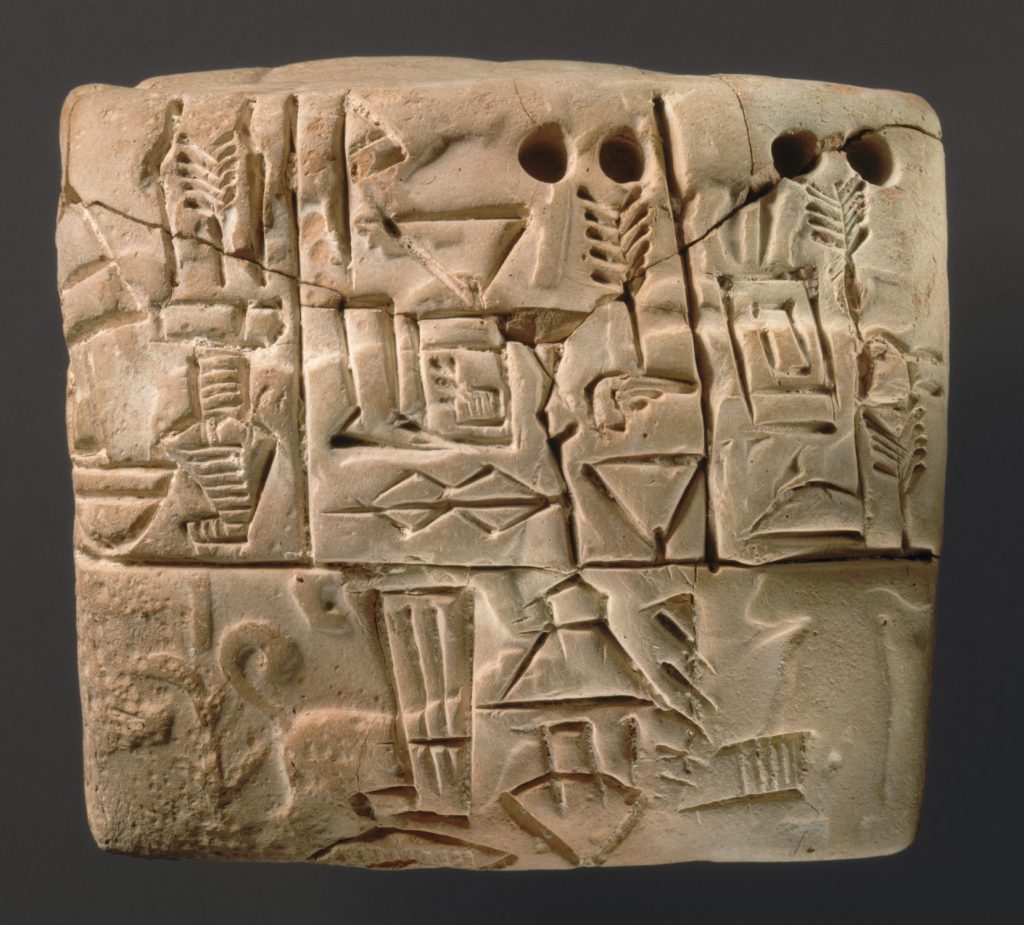Written language, which is perhaps taken for granted in the 21st century, was not common for early civilizations. Around 3,000 B.C.E. the first writing system was created by the Sumerians. The Sumerians developed their civilization in present day southern Iraq; they evolved into complex societies with large cities and centralized economies. The origin of their writing system developed to keep track of inventories of things produced, such as grain and livestock. From their records emerged the first written form of any language, called cuneiform.1
Literally meaning “wedged shaped,” cuneiform was written by using a stylist on a damp piece of clay. The clay was then baked to harden the inscription. Cuneiform developed from sounds of the Sumerian language. As time progressed, the writing became more and more complex. The forms went from being an inscription of an object, such as sheep, to more abstract representations of words, such as “the sheep walk to the temple.”2
Cuneiform is the oldest written language, but even the oldest language has its own origins. Recent archaeological research has found evidence for the origin of writing to be more complex than originally thought. Some recent discoveries of even older writing, called proto-cuneiform, were found in Syria and Turkey going back to the mid fourth millennium. These inscriptions are pictorial, much like hieroglyphs of Egypt. Many of them are decipherable, but most are so abstract that they cannot be identified with known objects. Some of these were even written on wood instead of clay. The tablets found from the Sumerian people are only a small fraction of the earliest writing. The Sumerian tablets are from the time when writing became standardized, as a result of rapidly growing Sumerian city-states. The need for a normalized way of writing with standard symbols that people could recognize was apparent, so they shifted from pictographs to a standard script. The script became the writing we know today as cuneiform, and it also became a new way to record other things, such as stories and legal codes.3

With the development of more complex writing came the first pieces of real literature. The Epic of Gilgamesh, written between 2150-1400 BCE, is the oldest known work of literature. The story comes from a long oral tradition that was passed by word of mouth for centuries. The development of cuneiform allowed the story to enter history as a written record. In addition to literature, legal writing emerged in the form of legal codes, such as the Law Code of Hammurabi, created sometime between 1794-1750 BCE. The Code of Hammurabi has almost three hundred laws that applied to the daily life of the Babylonians. The range of the law code is broad, from family life to administrative laws. The Code of Hammurabi is the oldest extensive law code known.4
Cuneiform set the stage for subsequent written languages. Its origins came from pictures, but then became representations of sounds of spoken language. Now writing is something people use everyday. People read books, articles, text messages on smartphones; all these means of communicating have their origin in cuneiform.
- Jerry Bentley, Herbert Ziegler, and Heather Streets Salter, Traditions & Encounters: A Brief Global History, Volume 1, 3 edition (McGraw-Hill Higher Education, 2013), 16. ↵
- Ancient History Encyclopedia, October 2010, s.v. “Cuneiform,” by Joshua J. Mark. ↵
- Ira Spar, “The Origins of Writing,” in Heilbrunn Timeline of Art History (New York: The Metropolitan Museum of Art, 2000–.) http://www.metmuseum.org/toah/hd/wrtg/hd_wrtg.htm (October 2004). ↵
- Bentley, Ziegler, and Salter, Traditions &; Encounters: A Brief Global History, 10-11. ↵



39 comments
Madeline Chandler
Such an informative and interesting article! Very captivating. Honestly, I am vaguely familiar with the origins of writing however I did not know the information this in-depth. It is interesting to think cuneiform was so crude compared to the current languages. I think this article truly highlighted the idea without the foundation of languages that we have discovered, if it has never existed we would not be the same now. I loved reading your article. Great job!
Alexander Johnson
It is interesting that writing was first implemented as a system of keeping track of things. This development makes sense as a progression, as humans have been arranging objects as memory devices for thousands of years (ie origins of math). A question I have is: As the systems of writing became more like hieroglyphics, who decided what each symbol would stand for? Was it arbitrary between different regions, or did the government declare specifics?
Christopher McClinton
The history of the basic languages and the advancements in the history of language. The setting that was created for the modern day writing symbols is really awesome. This was a very informative article. I truly have a better understanding the history of writing.
Cirilio Vivenza
It’s unfortunate that the proto Indo-European language is lost to the world as its written form would answer so many questions linguists and historians have covering ancient middle eastern nations all the way up to today. There is already enough evidence in Indo-European words such as numbers that hint at just how connected our origins are in the African, Asian, and European continents.
Victoria Salazar
I think the first of anything is fascinating, but the first of a written language is truly just mind blowing. I truly wonder how someone thought to engrave the clay so as to write things down and why it had to be done at the time. Today writing happens in everyday life, but there was a time before that was so. I guess it’s good someone developed writing so early on, so we could have accounts of stories back then like The Epic of Gilgamesh.
Micheala Whitfield
That’s truly fascinating how a culture used counting and turned it into a writing. It makes me intrigued on how they came up with the idea to turn the shapes into languages. Ah, the Code of Hammurabi. I personally enjoy this code. It was so ruthless and to the point. This was a great informational article. Well descriptive, simple and constructive on cuneiform. I enjoyed reading and learning something new.
Nydia Ramirez
I learned a little about this in my AP World History class but I loved how your article was extremely insightful and tied everything together. This led way to written languages and without this we would not have literature. It is always interesting to read articles like this because we don’t stop to think, “where did this come from?”, in our daily life. I had not heard of proto-cuneiform and it just makes you think about how far things actually date back to.
Daniel Gimena
Interesting article about one of the most important things in human history: the history of writing.
It is always exciting to learn about how things that today we take for granted, emerged in a completely different form as we know today.
This is the case of cuneiform writing. It is impressive how so many centuries ago the basics of all of our today’s languages were born. Cuneiform writing is one of those things that seem so meaningless for our eyes, but is so important for human history.
Juan Arceo
Every little thing has their origin but I never really stopped to think about how writing came to be. It is interesting to see how cuneiform essentially brought about writing and evidently transformed not just that nation, but ultimately the whole world. By developing a style of writing, several advancements were made with one of the most important being the Code of Hammurabi.
Diego Terrazas
Cuneiform is essentially the founding father of all writing> I really wonder how hard it is to learn; it may be meaningless, yet an interesting experience. Cuneiform did much more than simply giving us the ability to write down laws but it also gave us the ability to write stories, which is a means to show that we are a very much alive civilization. Without a means of writing, much would be forgotten.